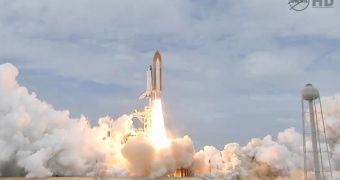Even after their retirement from active duty, the three operating NASA space shuttles will be providing experts at the American space agency with a wealth of data. As the orbiters are prepared for permanent displays at several museums, technicians have been instructed to remove many parts for analysis.
Some of these components include the massive engines that power the orbiter, the windows that protect the crew from the void of space, the nose cone housing the heat shield, as well as many, many others.
NASA is hoping that – by studying these parts – it will be able to improve the design of its future vehicles, incorporating lessons that have been learned from the shuttles. Engineers will now get the chance to look at the orbiters in a way that they were unable to while the spacecraft were operating.
Officials say that the spacecraft will not be exposed with all their original components. The main engines are scheduled to be shipped to a NASA facility for in-depth testing, whereas some systems are simply too hazardous to allow in a public museum.
In turn, engineers say that they could use the expertise these parts provide to inform the design of future spacecraft. At the same time, some of the components have life in them still, which means that they could very well be used again.
“No other vehicle has had anywhere close to the same number of cycles on a lot of this hardware as the shuttle has. Some of this stuff is 25 years old or more,” NASA official Jonathan Krezel explains.
“So from the point of view of creating long-duration survivable space systems in the future, there's a lot of interest,” adds the expert, who is the leader of the shuttle transition and retirement program at NASA Headquarters, in Washington, DC.
“We're making the vehicle not just safe for trained technicians to walk around, but safe for the public to walk around. My favorite phrase is, to make it lickable,” Krezel adds in an interview for Space.
An important aspect of the process, for example, is detaching the shuttles' nose cone thruster system, cleaning it of all the toxic chemicals they contain, and then reattaching them back on. Another example is taking off all the explosive charges that are embedded in the shuttles.
These charges perform certain well-defined functions, such as for example deploying the landing gear, if normal and back-up systems fail. They were never used during the actual missions, but were there just in case something went wrong.
“A lot of this stuff hasn't been taken off since the vehicles were first built. So it's a dataset that the agency has not had access to, ever. That's a lot of components. That's valves, that's seals, that's actuators. That's various pieces of plumbing, filters, etc.,” Krezel explains.
After processing, the shuttle Discovery will go to the Smithsonian Air and Space Museum, in Washington, DC, Endeavour will be displayed at the California Science Center, in Los Angeles, and Atlantis will remain at the NASA Kennedy Space Center (KSC) Visitor Complex, in Florida.

 14 DAY TRIAL //
14 DAY TRIAL //